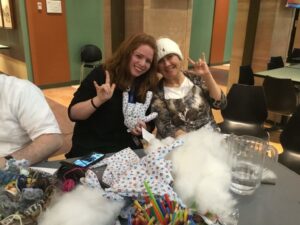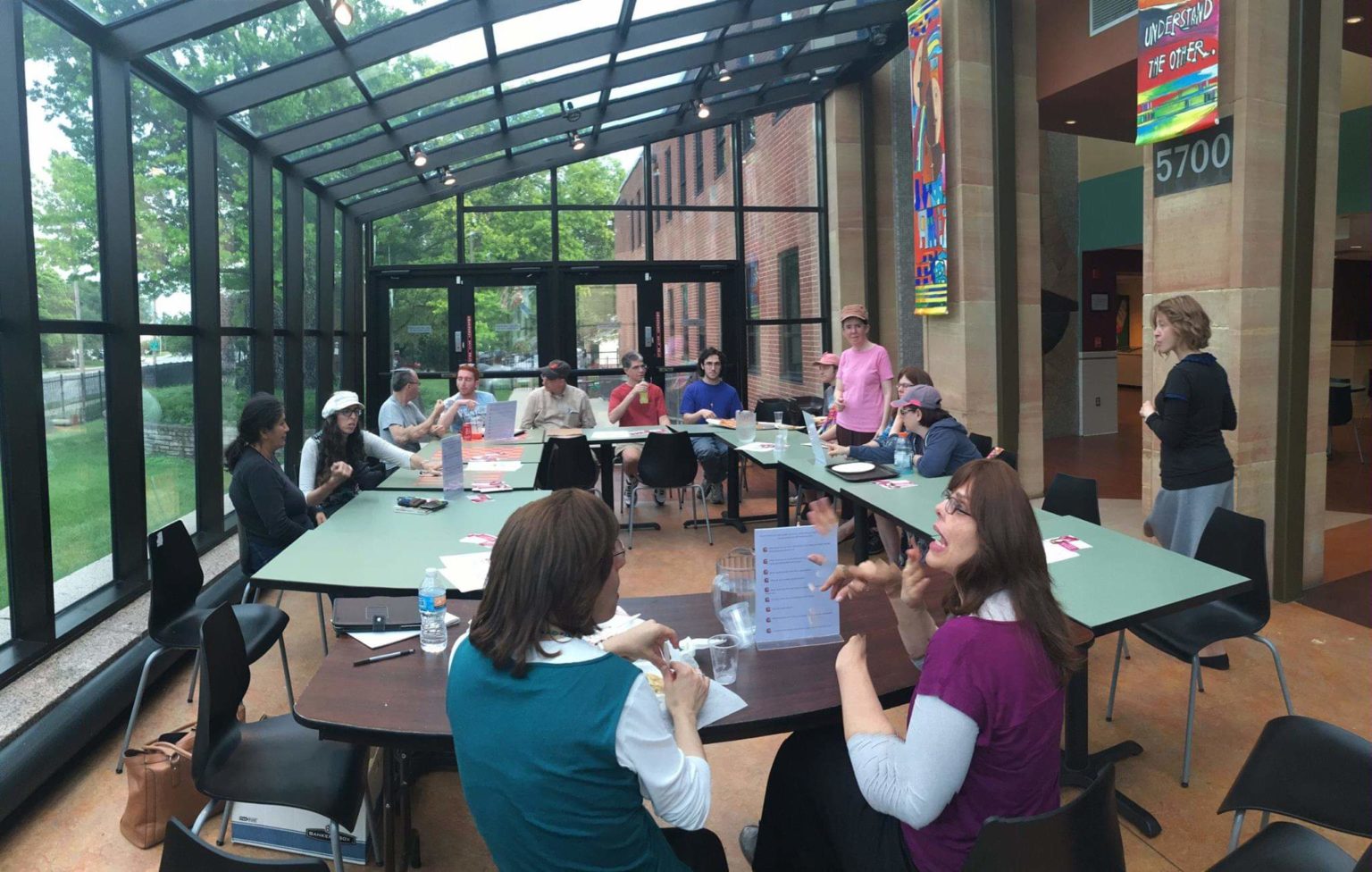Photo credit: CJE ASL monthly meetup (courtesy of Ziegler)
By Carolyn Conte
August 12, 2020
Baltimore Jewish Times
Three years ago, Dina Cotton, a local Jewish woman, told Yael Zelinger, the Center for Jewish Education’s disability and inclusion advocate, that she wanted to be more connected to the community. However, Cotton was hard of hearing and did not use American Sign Language. She asked Zelinger about captioning for local events and videos.
That began a project to make the Jewish community a more welcoming place for the deaf and hard of hearing.
Now, Zelinger and CJE’s team at Jewish Advocates for Deaf Education, or JADE, have used the increase in virtual events as a chance to increase community participation by adding more captioning.

“When COVID-19 hit, everything went virtual. Our team quickly pivoted to learn more about how to make live digital events accessible to people who are deaf or hard of hearing,” said Zelinger, who said she does more of the advocacy side than the logistics of the project.
Photo credit: ASL meetup (ziegler)
One of the newer opportunities includes the use of speech-to-text technologies, such as Otter and LiveTranscribe. These can be used during in-person events and conference calls. Many conference call platforms, such as WebEx and Google Meet, offer free auto-captions for meetings. (Zoom does not offer free auto-captions right now). The best new option is remote conference captioning, a free service by Maryland Relay.
“This is much more accurate than auto captioning,” Zelinger said. She also noted that, “You’re talking about a Jewish event, so they also have to know the Jewish lingo. So we initially sent vocabulary in advance like names of the speaker or Hebrew words they might use.”
Last year, the CJE through The Associated: Jewish Federation of Baltimore, had a grant for CART, a program that provided live captions for community events. It is uncommon for programs to have live captions, because they are expensive. So, through the Access Fund, JADE provides partial funding for ASL interpreters or other interpreters for Jewish events.
“For some classes they have ASL interpreters, but there are people who are deaf who don’t sign. It’s not a one-size-fits-all solution,” CJE’s Martha Goodman said.
Videos, too, present challenges. While some organizations do caption videos, most videos do not have accurate captions. In addition to the Access Grant to caption Jewish-interest videos, JADE trains volunteers to correct captions, primarily with YouTube software.
“There are a lot of different pieces. Part of it is fielding requests from people. There’s also the advocacy part, making sure things are accessible,” Goodman said. And then there is the technical side of captioning. Plus, “More tech is coming out,” Goodman said.
Most recently, the Orthodox Union asked JADE to help it promote Tisha B’av fasting events in a way that included the deaf community.
Although it can be difficult, Zelinger is proud they are able to welcome such a wider audience now. Zelinger herself knows of around 30 people in Baltimore who benefit from the captioning, but notes that for online events now, deaf Jews all over the world can join.
Even within Baltimore, though, there are many more people she wants to reach. “There are so many more people here who I don’t know,” Zelinger said. One testament to that is strangers reach out to ask for strobe lights at events, in case of an emergency, so that they can know if the smoke alarm went off.
Another way JADE is connecting Baltimore’s Jewish deaf community is through monthly ASL meetups. Participants sign up or are in the community through family.
Shira Ziegler, 50, of Quarry Lake, is one such deaf community member who’s found a sense of family in the community. The captioning has also been a practical benefit for her.
“I can’t hear, but I can read. Captions help me understand everything around me like T.V., the news, YouTube, Zoom meetings. If something has captions, I can understand it, if not, I’m left OUT,” she wrote in an email. “I don’t understand and I would be TOTALLY lost if someone were speaking and there were no captions.”
Ziegler noted the community itself has also been growing. Though slower than the hearing community, she knows of a couple deaf Jews who have moved here in recent years. This is significant because the deaf community has its own culture.
Part of that culture is a sense of being outsiders.
“Deaf Jews feel connected like we are part of our own world. It feels right, comfortable, with other deaf people. When we meet each other for the first time we can talk for hours, unlike hearing people who say hi, ask each other’s names and walk away,” Ziegler said.
She remembers one time she was starkly aware of the cultural difference. Ziegler and a deaf friend were eating in a restaurant and signing to each other. “We were laughing really hard about something and I was banging on the table laughing hysterically. Suddenly I realized that everyone was staring at us. I didn’t realize we were making so much noise! I felt so bad. I wrote on a napkin, ‘sorry’ …Hearing people look at the deaf community and feel awkward. They wonder, ‘How do I communicate with them?’”
She suggests hearing people learn to use gestures and to point at what they are talking about or write things down. “It’s important not to be afraid,” Ziegler wrote. “It’s important to try to speak slowly. Sometimes a deaf person may do something that clashes with hearing culture. The hearing person should just gently point out what was wrong.”
Especially with everyone wearing masks that hide their face, Ziegler pointed out that she is facing more challenges now that her normal attempts to read lips and facial expressions are now impossible.
What motivates Zelinger is connecting all communities to the larger whole. “This is a whole micro-community that gets left out. The community is not complete and you can’t talk about unity if we can’t all come to the table,” she said. “Imagine if I invite you to Shabbat dinner and you say, ‘I’m not sure if I can make it,’ and Friday night you knock on the door and I say I didn’t set a plate because you didn’t say you were coming. Alternatively, what if you come and I set a place for you just in case? If you compare that to when you set up an event, accessibility means we want you there.”
Ziegler hopes the two communities can join more often. “I love my deaf world; I’m deeply enmeshed in the deaf community. As far as the hearing world, I respect them. They are both good communities but very different. The deaf community feels warm, easy to get along with, communication is easy. The hearing community feels polite, but we have to work hard to communicate with patience.”
Source: www.jewishtimes.com/110696/asl-captioning-baltimores-jewish-deaf-community/news/local-news/




